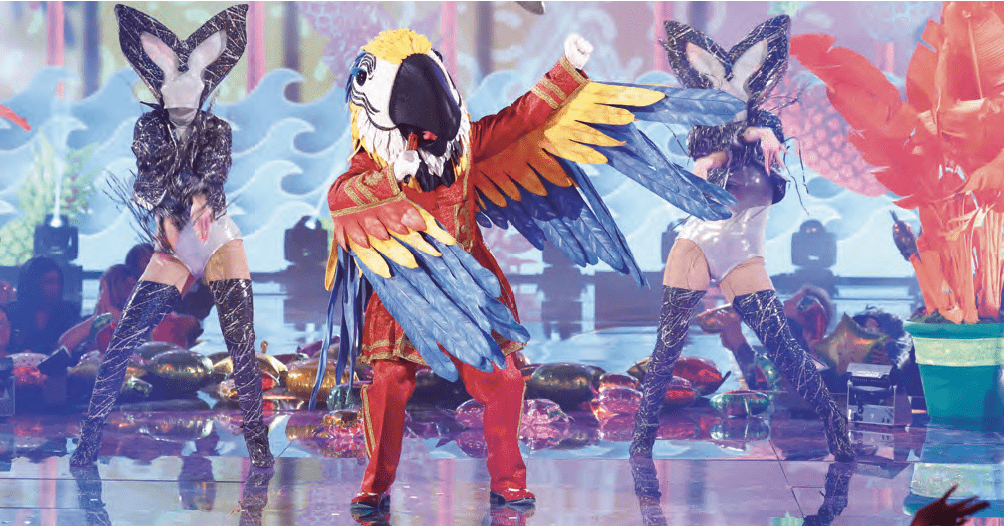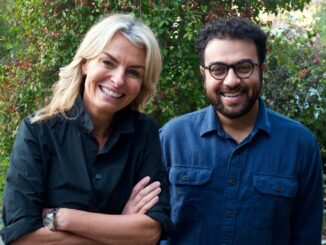
By Rob Feld
The first time many crew members behind “The Masked Singer” saw a version of the show was on television in Thai restaurants. It was the South Korean forebear, “King of Mask Singer,” with contestants donning elaborate masks and gloves as they competed in a singing competition.
“It looked crazy,” recalled editor David Greene.
The American version, which premiered on Fox in 2019, places celebrities from Margaret Cho to William Shatner to Johnny Rotten in elaborate disguises, singing for a studio audience and a celebrity panel tasked with guessing their identities. Having completed its ninth season in May, the show features elaborate performances and is shot with 18 cameras, augmented by pre-cut “clue packages” that tease the guests’ identities.
All the cameras are trained on the guests and judges on stage, meaning that audience reactions—so key to the storytelling—are captured during the video playback of the performance they just experienced live. Practical production constraints such as these have the edit team working every trick in their toolbox to bring surprise, suspense, and variety to a series with quick turnaround times.
To explain how they do it, CineMontage visited with team members David Greene, Samantha Diamond, David Timoner, Brett Snyder, Vicente Bruguera, and Patrick McElroy.
CineMontage: There are a lot of logistics behind this show—can you talk about the workflow?
Vicente Bruguera: It’s a show that requires many elements, from graphics to sound design, and since the schedule is a bit tight from the recording moment to air day, the editors of the main show are divided between even and odd episodes. But as the weeks go by, we become one team.
David Greene: The live element is a major factor in what we do in post. They try their best to shoot an act in a straight-forward way, live, but obviously it’s usually two to four times longer than an 8-minute act. So, cutting to feel live is a big part of it. Pacing is very important, and the crowd is a character. Watching them play along with the game is pivotal when we cut the live acts, even down to their performances. How can we enhance the story of the audience playing against the comments made by the panel? We have to have the right number of red herrings or little clues, while making it feel live. We do a ton of work in post to narrate the story in the way that we need.
CineMontage: So, you’re utilizing audience reaction footage wherever needed and not reactions to that exact performance, I assume?
Greene: It is exactly that and probably pretty rare that we cut to an actual reaction to a moment. We always want to tell a story throughout the performance of, is the performance good or not? And then, who could the performer be? So, we’re cutting to the audience as they’re trying to figure out who it is, then slowly starting to enjoy the performance and getting increasingly into it. But it’s actually a very difficult task because you don’t want to mess with the performance choreography—which is really well shot and laid out—while telling the story of the game.
Samantha Diamond: The studio audience isn’t that large and the producers don’t want to see the same audience members again and again. So, even if it’s a really great reaction that actually happened in the moment, we can’t use it because that person’s been seen too many times in the episode.
Brett Snyder: The audience is sort of trained at the top of each day on how to act out and a lot of it is shot on a separate pass during playback of the performance.
Diamond: Or taken from a different episode.
Bruguera: It was very difficult, especially during the performances, because we had to find the audience shots that matched the lighting, the rhythm of the song, and also the emotion we were trying to convey.
Snyder: The AE’s do a great job of organizing bins of audience for each performance. Different emotions, laughing, clapping — “trying to figure it out” is one of the categories. David Timoner: Disagreeing, agreeing. “Trying to figure it out” is a tough one because you’re really relying on them being good performers.
Greene: There’s a lot of overacting. We really play director and ask, how is this performance? Are they overdoing it? Are they underdoing it? Because the show has a fun, exaggerated vibe, you can add exaggerated responses, and those seem to be the ones that survive the notes.
Diamond: Subtlety doesn’t play on our show.
Snyder: When COVID hit, we didn’t have an audience for season 4, so we cut with old audience footage. Timoner: We had a crazy camera angle with fake heads in it, and there was some CG audience, too.
CineMontage: How are the acts structured?
Greene: The first has a pretty grand cold open intro and a quick bit on the rules. Then we introduce the first character pretty quickly, a walkout, and go into a clue package that will give the audience lots of clues. Then the performance kicks off. Then we get reactions from the panel—a couple just commenting on how well they did or how fun they were—which leads into a stage clue and guessing from the panel and audience. Those are the acts introducing a performer, which lead into the reveal acts David [Timoner] and Samantha usually take.
Bruguera: Another special thing about this show is that each episode has a different theme, and we have to find creative ways to approach that vision in the editing process with fun graphics or effects. For example, on movie night, we might edit an opening in the style of “The Matrix,” or on Muppets night, we need to find ways to involve all the characters and allow each one to shine with their own distinctive personality.
CineMontage: Working from home during COVID changed so much—I’m thinking about how rare the old-school apprentice experience has become. Editing is such a social and collaborative job. How do you compensate and what has been lost?
Bruguera: We were fortunate to start working on this show before the pandemic. I feel like that’s why there is great communication within the entire post-production team. Additionally, when it comes to locking an episode, we do it in person with the producers to prevent anything from being lost in a text. It makes everything run so much smoother and faster.
Greene: You really have to work on your personal connections outside of Zoom. Sam and I try to do lunches. You have to make sure that you’re still seeing each other. I think we’re lucky—most of us worked together before the pandemic and have been on the show long enough to have a relationship with each other. A huge part of our industry is the camaraderie—editors, but also editors and the producers. It’s such a collaboration. There are many times when I’m digging into something where if I didn’t have that relationship with an executive, it would be much more difficult to create the TV that we’re creating on the level that we are.
Snyder: Also, a lot of the same people do these competition shows. Name any show: “American Idol,” “America’s Got Talent,” “The Voice,” “Dancing with the Stars”; it’s a lot of the same people. So, get on any Zoom call for a new show and you know more than half the people there.
Timoner: But it is a hard format to crack in the beginning, I don’t know how successful we’d be starting off all remote.
CineMontage: I think frequently about connecting an audience with a character through the character’s eyes. With your characters in masks, how do you get people emotionally invested in them?
Greene: It’s kind of funny sometimes. A lot of the heads don’t move. We cheat a lot of shots to take advantage of any gesture.
Bruguera: And we not only take into consideration the contestants’ body language but also take advantage of any sound ups to help reinforce any moment in the episode, like a chuckle or a simple “thank you.”
Diamond: We’ve had a few costumes that were huge and beautiful, they just didn’t move very well, and so we had to really dig in to see even the slightest little tilt of a head or something, and use it as much as possible, because that’s what makes it feel alive. But the costume department is off-the-chain amazing with what they create for these people. When Kermit the Frog was inside the snail, they made the antennas and eyebrows move.
Greene: I try and pay close attention to body language. Sometimes I’ll get a note to cover a section with an audience shot but I’ll argue that, no, the performer is doing something with their shoulders or their head that’s connecting them to the audience. So, it’s pacing and always paying attention to how the performer is gesturing and moving, then digging that out throughout the act. I’m working on a performance now where the performer finishes and drops to their knees. When you have moments like that, the body language gives you so much.
Snyder: I also think the audience brings an emotional attachment to the music and songs it recognizes, which helps. Timoner: You’re telling the at-home audience how to feel when you cut to reaction from the panel or studio audience. The network is obsessed with the audience for that very reason.

CineMontage: Tell me about cutting the clue packages.
Patrick McElroy: The process of making the clue packages is fun and unique. Before shooting the final packages, we actually make a temp package cut together from a drawing of each costume, stock footage, or whatever else we can find to visualize and storyboard the package. Some of those end up really cool even as temp, but their purpose is to allow us to see that we are telling compelling stories. Each one is distinct and the creativity that goes into them is a lot of fun.
It’s a wacky show and I like to think of each package as part of a little behind-the-scenes world where these characters live when they aren’t singing on the show. It’s easy to get carried away and have fun with them, approaching it this way. I usually don’t know who the person is under the mask, and I try my best not to know; by not knowing, sometimes happy weird things can happen while editing. We shoot in a 3D greenscreen environment, which tracks the camera’s movement against a background. It gives us a lot of leverage for effects by separating the layers of the shoot when we need to.
But the most important thing is that we’re a team of people who all like working with each other, and we always want to try to notch things up where we can. There’s a lot of opportunities to push what you can do on these packages, and I think as a team we all enjoy it. It reminds us of why we like to edit in the first place.






